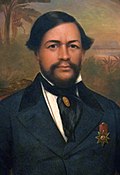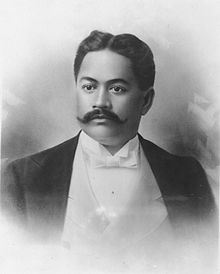Hawaiian Kingdom/Kingdom of Hawaii de jure vs. A Treasonous Prince Kuhio Who Supported (Committed Treason) the Identity Thieves - entity Provisional government to Republic to Territory to State Defended by the U.S., and the American Empire
overview by Amelia Gora (2015)
Hawaiian Kingdom/Kingdom of Hawaii de jure:
Hawaiian Monarchs (1795–1893)[edit]
Kamehameha Dynasty (1795–1872)[edit]
| Name | Portrait | Birth | Marriages | Death |
|---|---|---|---|---|
| Kamehameha I Spring, 1795 — May 8, 1819 |
 |
c. 1758 Moʻokini Heiau,Kohala, Hawaiʻi island son of Keōua andKekuʻiapoiwa |
various | May 8, 1819 Kamakahonu, Kailua-Kona, Kona, Hawaiʻi island aged 61? |
| Kamehameha II May 20, 1819 — July 14, 1824 |
 |
c. 1797 Hilo, Hawaiʻi island son ofKamehameha Iand Keōpūolani |
(1) Kamāmalu (2) Kīnaʻu (3) Kekāuluohi (4) Kalanipauahi (5) Kekauʻōnohi (6) Kekai Haʻakulou |
July 14, 1824 Caledonian Hotel,London, England aged 27 |
| Kamehameha III June 6, 1825 — December 15, 1854 |
 |
August 11, 1813 Keauhou Bay,North Kona,Hawaiʻi island son ofKamehameha Iand Keōpūolani |
Kalama Honolulu, Oʻahu 14 February 1837 two sons |
December 15, 1854 Honolulu, Oʻahu aged 41 |
| Kamehameha IV January 11, 1855 — November 30, 1863 |
 |
February 9, 1834 Honolulu, Oʻahu biological son ofKekūanāoʻa andKīnaʻu and hānai son ofKamehameha IIIand Kalama |
Emma Rooke Kawaiahaʻo Church,Honolulu, Oʻahu 19 June 1856 one son |
November 30, 1863 Honolulu, Oʻahu aged 29 |
| Kamehameha V November 30, 1863 – December 11, 1872 |
 |
December 11, 1830 Honolulu, Oʻahu biological son ofKekūanāoʻa andKīnaʻu and hānai son ofNāhiʻenaʻena(later) Hoapili andKaheiheimālie |
Never married | December 11, 1872 ʻIolani Palace,Honolulu, Oʻahu aged 42 |
| Lunalilo January 8, 1873 – February 3, 1874 |
 |
January 31, 1835 Pohukaina,Honolulu, Oʻahu son of Kanaʻinaand Kekāuluohi |
Never married | February 3, 1874 Haimoeipo, Honolulu,Oʻahu aged 39 |
Kalākaua Dynasty (1874–1893)[edit]
| Name | Portrait | Birth | Marriages | Death |
|---|---|---|---|---|
| Kalākaua February 12, 1874 — January 20, 1891 |
 |
November 16, 1836 Honolulu, Oʻahu biological son ofKapaʻakea andKeohokālole and hānai son of Kinimaka and Haʻaheo |
Kapiʻolani December 19, 1863 no issue |
January 20, 1891 Palace Hotel, San Francisco, California,United States aged 54 |
| Liliʻuokalani January 29, 1891 – January 17, 1893 |
 |
September 2, 1838 Honolulu, Oʻahu biological daughter of Kapaʻakea andKeohokālole and hānai daughter ofPākī and Kōnia |
John Owen Dominis ʻAikupika, Haleakala Estate,Honolulu, Oʻahu September 16, 1862 no issue |
November 11, 1917 Washington Place,Honolulu, Oʻahu aged 79 |
vs.
A Treasonous Prince Kuhio Supporting the Identity Thieves - entity Provisional govt to Republic to Territory to State Defended by the U.S., and the American Empire
EXPOSING THE TREASONOUS JONAH KUHIO KALANIANAOLE AND DAVID KAWANANAKOA'S..Updated 4/07/2013
Jonah Kūhiō Kalanianaʻole
| Jonah Kūhiō Kalanianaʻole | |
|---|---|
| Prince of Hawaiʻi | |
 |
|
| Spouse | Elizabeth Kahanu Kaʻauwai |
| Full name | |
| Jonah Kūhiō Kalanianaʻole Piʻikoi | |
| House | House of Kalākaua |
| Father | David Kahalepouli Piʻikoi King Kalākaua (hānai) |
| Mother | Victoria Kekaulike Kinoiki Queen Kapiʻolani (hānai) |
| Born | March 26, 1871 Kōloa, Kauaʻi |
| Died | January 7, 1922 (aged 50) Waikīkī, Oʻahu |
| Burial | January 15, 1922[1] Mauna ʻAla Royal Mausoleum |
| Signature | |
Contents[hide] |
[edit]Early life
[edit]Prince of the Kalākaua Dynasty
[edit]Post-Overthrow Activities
[edit]From prince to American statesman

[edit]References
- ^ Roger G. Rose, Sheila Conant and Eric P. Kjellgren. "Journal of the Polynesian Society". Polynesian Society. pp. 273–304. Retrieved 2011-09-18.
- ^ Mart Martin (2001). The almanac of women and minorities in American politics (2nd ed.). Westview Press. ISBN 978-0-8133-9817-4.
- ^ United States Congress (1910). Official Congressional Directory. U.S. Government Printing Office. p. 139.
- ^ a b c Pat Omandam (September 20, 1999). "Kuhio’s advice still relevant today". Honolulu Star-Bulletin. Retrieved 2009-11-27.
- ^ Agnes Quigg (1988). "Kalākaua's Hawaiian Studies Abroad Program". Hawaiian Journal of History (Hawaii Historical Society) 22: pp. 170–208. Retrieved 2010-02-04.
- ^ Ann Rayson (2004). "Chapter 3: Prince Kūhiō and the Hawaiian Homestead Act". Modern History of Hawaii. Bess Press. ISBN 978-1-57306-209-1.
- ^ a b Stu Dawrs (April/May 2002). "Civic Pride". Hana Hou! Vol. 5, No. 2.
- ^ a b Jonah Kūhiō Kalanianaʻole at the Biographical Directory of the United States Congress
- ^ Parker Widemann (February, 1980). "Founding of the Hawaiian Civic Club of Honolulu". official web site. Hawaiian Civic Club of Honolulu.
- ^ a b "Kalanianaole, Jonah Kuhio, Prince office record". official archives. State of Hawaii. Retrieved 2009-11-27.
- ^ Rayson, Ann (2004). Modern History of Hawaii. Bess press. ISBN 1-57306-209-X. (a high school textbook on Hawaiian history, see especially chapter 3: "Prince Kūhiō and the Hawaiian Homestead Act")
- ^ "Jonah Kūhiō Kalanianaʻole". Find a Grave. Retrieved October 16, 2010.
[edit]External links
| Wikimedia Commons has media related to: Jonah Kūhiō Kalanianaʻole |
- "Prince Jonah Kuhio Kalanianaole". Papakōlea Community Association. 2004. Retrieved 2010-01-02.[dead link]
- Taegan D. Goddard (January 1, 2010). "Friday Night Trivia". Political Wire. Retrieved 2010-01-02.
- Henry Soszynski. "HH Prince Jonah Kuhio Kalaniana'ole Kawānanakoa". web page on "Rootsweb". Retrieved 2010-01-02.
- "Prince Jonah Kuhio Kalanianaole". Our Family History and Ancestry. Families of Old Hawaii. Retrieved 2010-01-02.
- "Prince Kuhio: The bridge from Kingdom to State".
- "Kalaniana‘ole as pronounced by a native speaker".
| United States House of Representatives | ||
|---|---|---|
| Preceded by Robert William Wilcox |
Delegate to the U.S. House of Representatives from Territory of Hawaii 1903–1922 |
Succeeded by Henry Alexander Baldwin |
David Kawānanakoa
| David Kawānanakoa | |
|---|---|
| Prince of Hawaiʻi | |
 |
|
| Spouse | Abigail Wahiʻikaʻahuʻula Campbell |
| Issue | |
| David Kalākaua Kawānanakoa Abigail Kapiʻolani Kawānanakoa Lydia Liliʻuokalani Kawānanakoa |
|
| Full name | |
| David Laʻamea Kahalepouli Kinoiki Kawānanakoa Piʻikoi | |
| House | Kalakaua Kawānanakoa |
| Father | David Kahalepouli Piʻikoi King Kalākaua (hānai) |
| Mother | Victoria Kinoiki Kekaulike Queen Kapiʻolani (hānai) |
| Born | February 19, 1868 Honolulu, Oʻahu |
| Died | June 2, 1908 (aged 40) San Francisco, California |
| Burial | June 21, 1908[1] Mauna ʻAla Royal Mausoleum |
| Signature |  |





Replies
I'm a long time researcher. history and genealogies and law.......
If there were more researchers we could move much quickly.....but do realize that we are from families with issues of genocide.....
there's much going on behind the scenes and maoliworld connects only to some of the legitimate people, the truly interested......meanwhile there's ongoing issues away from Maoliworld ..........
learn more by reading some of the old posts or checking out the websites http://myweb.ecomplanet.com yahoogroups.com under hawaiian genealogy society www.theiolani.blogspot.comwww.iolani.wordpress.com www.ameliagora.wordpress.com
and http://myweb.ecomplanet.com/GORA8037
if you've been involved in researching as long as some of us, normally, many would not want to share any information........i just wonder why the heck noone followed up on Queen Liliuokalani's issues.....even in her Will she maintained she did not sign a trust......I wonder about my own ohana for not exposing any of this crap sooner......
the crap is that a branch of family which was adopted did cause big time pilikia making agreements with KUHIO and KAWANANAKOA..........and she was not descendants of the true trustee..........now, this project is being worked on.......... and that info in part has been shared only with select people who are not necessarily ohana.....
"we are all ohana" is a lazy copout and disregarding the fact that direct lines exist.
The above post has changes, the bold letters show the changes effective 09/2010:
Kamehameha had 10+ documented wives. He had 19+ children of his own. He was Kalaniopuu's, and Kaumualii's children's step father.
Kamehameha II had 8 documented wives. He was Kalaniopuu's, Kamehameha's, and Kaumualii's children's step father, as well as being their sibling.
Kamehameha III had 4 documented wives. He had ten (10) children. He had several hanai hookama/ adopted children who inherited sovereignty and stepchildren documented.
Kamehameha IV had 1 documented wife. Kamehameha IV's mother was married to Kamehameha II before she married Mataio Kekuanaoa. His mother was Kalaniopuu's, Kamehameha's, and Kaumualii's children's step mother, which means Kamehameha IV was a step sibling of all of them.
Kamehameha V was unmarried. His mother was Kalaniopuu's, Kamehameha's, and Kaumualii's children's step mother, which means Kamehameha IV was a step sibling of all of them.
King Lunalilo was unmarried. King Lunalilo was Kalaniopuu's, Kamehameha's, and Kaumualii's children's step sibling. His mother was married to both Kamehameha and Kamehameha II.
King David Kalakaua had 2 documented wives. He had 2 documented children and 3 adopted children (Kahanu (k); Rose (k), and a yet to be verified adopted son) of which the Kawananakoa's are NOT a part of.
Queen Liliuokalani had 4 documented husbands (Kaumauma, Koolau, Maulili, John Dominis).
She said the following were here children/hanai: Abigail/Abigail Maikai/Kapooloku/Kapapoko/Poomaikelani/Princess Poomaikelani; Kaaumoana/Luka aka's; Kaeha opio(w); Ioane (k); Kamukai (k); Wahie (k); Pau (k) et. als.
Princess Likelike had 1 documented husband and 1 documented child named Kaiulani/ Princess Kaiulani. The claimed descendants of Cleghorn are NOT related to the Kalakaua, Liliuokalani lines. They are called the ILLEGITIMATE children of Cleghorn, a Mason/Freemason. They have ties to Treasonous person Sanford B. Dole, one of the many genocide activists of the period.
Princess Poomaikelani, sister of Queen Kapiolani, was listed before Princess Kinoiki, and BEFORE the Princes Kuhio, Kawananakoa, and Abner.
Princess Poomaikelani had her own children: Samuel (k); Alapai (w); Haili/Kaili/Kalama (w) and Elizabeth Mana; she had stepchildren named Abraham Kekai, et. als.
Hawaiian Kingdom/Ko Hawaii Pae Aina Tribunal Results on ...
Bob Marley - Redemption Song (from the legend album, with lyrics)
[edit]Life
[edit]References
Replies to This Discussion
House of Kawānanakoa
Contents
[hide][edit]Origins
King Kalākaua (hānai)
Queen Kapiʻolani (hānai)
Kōloa, Kauaʻi
Waikīkī, Oʻahu
Mauna ʻAla Royal Mausoleum
Abigail Kapiʻolani Kawānanakoa
Lydia Liliʻuokalani Kawānanakoa
Kawānanakoa
King Kalākaua (hānai)
Queen Kapiʻolani (hānai)
Honolulu, Oʻahu
San Francisco, California
Mauna ʻAla Royal Mausoleum
Edward Keliʻiahonui
Kingdom of Kauaʻi
Honolulu, Oʻahu
Honolulu, Oʻahu
[edit]Early life
[edit]Prince of the Kalākaua Dynasty
Now, Let's Look at the Truth About the Princes Kuhio, Kawananakoa, and Edward :
King Kalākaua (hānai)
Queen Kapiʻolani (hānai)
Kōloa, Kauaʻi
Waikīkī, Oʻahu
Mauna ʻAla Royal Mausoleum
Abigail Kapiʻolani Kawānanakoa
Lydia Liliʻuokalani Kawānanakoa
Kawānanakoa
King Kalākaua (hānai)
Queen Kapiʻolani (hānai)
Honolulu, Oʻahu
San Francisco, California
Mauna ʻAla Royal Mausoleum
Edward Keliʻiahonui
Kingdom of Kauaʻi
Honolulu, Oʻahu
Honolulu, Oʻahu
[edit]Early life
[edit]Prince of the Kalākaua Dynasty
[edit]References